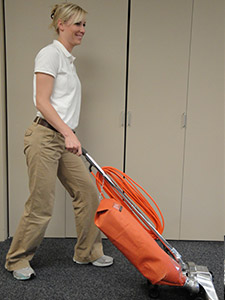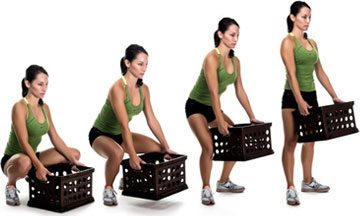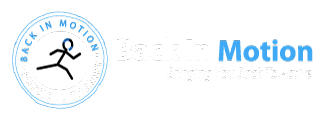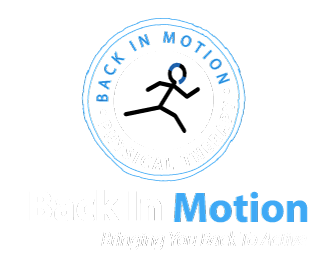Is spring cleaning causing you back pain?

It’s that time of year again! Time to dust off the book shelves, get rid of old hats and coats, reorganize the garage, deep-clean the house. Spring Cleaning–the great season of making everything fresh and new. Out with the old, in with the new. But those weekend warriors out there beware, improper form while cleaning out the shed and tidying up the house can lead to serious back pain.
How Can Cleaning Hurt My Back?
If not conscious of how we’re moving, sometimes our posture and body mechanics can have ill effects on the body. While we’re spring cleaning, back pain can arise from being stooped over vacuuming, mopping, raking leaves, or pushing the lawn mower; constantly bending over from the waist while doing laundry, picking up toys from the floor, gardening, or twisting down into hard-to-reach areas to dust or clean can also lead to a sore back and painful next week.
Often times, bending and lifting from the waist puts harmful strain on the back when we don’t recruit the proper muscles, or if we already have weakness in the legs and core. Keeping good form and strengthening our legs, back, and core muscles can help prevent back pain.
Some Tips to Prevent Back Pain while Spring Cleaning
1.Use a lunge position. Lunge forward instead of leaning from the waist while vacuuming, mopping, and raking. It is important to keep the back straight while performing these taxing activities to avoid pain and to create more strength in the core and back. You can do this by using the legs to bear some body weight. Stepping forward with one leg and bending that leg, in a lunging action will help to keep the back from hunching forward. We want to keep the back straight, front knee bent, and the vacuum close to us; we step forward to avoid reaching our arm to far forward which hunches the back and can make for pain in the spine.


*Photos courtesy of Tristate Arthritis & Rheumatology, click here to read more on their advice for better posture in daily activities.*
2. Lift with the legs instead of the back. When picking toys off the floor, a pile of leaves off the ground, or the laundry out of the basket, bend your legs into a squat instead of bending over at the waist as much. This will help strengthen the lower body and take the strain out of the low back . Make sure your feet and knees are wide enough apart, at least hip distance. It also helps to angle your toes out to the corners a little. Bend deeply in the knees and allow the back to stay straight as you use the arms to grab the object and push down into the floor with the feet to straighten the legs and lift the object.

You can also take one knee down to the floor for more stability and balance.

These processes can be reversed when you put something heavy down on the floor.
3. Engage your core muscles. Any time you reach, bend, or twist, make sure you engage the core muscles by pulling your belly button into the spine. This will help protect the back from harm. This technique is called abdominal bracing and will be helpful in nearly every moving activity, especially carrying, lifting, and reaching.
4. Don’t lock the knees while standing. If you’re in a stationary position dusting or reaching up for something, be sure to keep a soft bend in the knees. Locking out the knees is often accompanied by arching the back and uneven weight distribution in the feet. Keep the knees gently bent to help encourage a straight spine and the core engagement from tip #3.
5. Protect the knees when kneeling to clean down low, or avoid kneeling altogether. If you can avoid kneeling while you clean in low places by sitting on a stool nearby, then that will help preserve your low back and knees. If you absolutely have to kneel, be sure to place a folded towel or pillow underneath your knees to take some of the painful pressure off that joint. Remember, knee health and back health often go hand in hand.
6. Only use safe steps or ladders. If you need to reach a high area, like dusting a ceiling fan or placing tools back on a high shelf, make sure you use a safe, dependable step-stool or ladder. Do not strain to reach on your tip-toes. Do not use a bar stool or dinning room chair. These surfaces are not meant to be climbed on and could tip over easily. Make sure your step stool is placed evenly on the ground, not having one leg or foot on a carpet or elevated surface; this could add instability. If you use a step-stool to get higher, be sure you can get high enough and close enough so you don’t have to lean and reach too far.
7. Save your back while doing dishes. If you’re going to be standing at the sink for a long time washing the dishes, help your back from aching by opening one of the cabinet doors under the sink and place one foot inside the cabinet. Doing this will bend one leg and flex that hip forward, taking the strain out of the back.

8. Keep movements small and controlled. We want to encourage correct movement to avoid creating back pain or posture problems, so keeping movements small and required tools/objects close to you will prevent you from over-reaching or twisting. Instead of twisting and moving at the same time for mopping, try to turn your body to face the direction you want to mop, then keep the mop close to your body to avoid leaning too far. In every spring cleaning activity, keep this tip in mind! Small, controlled movements keeping your task close to the body will reduce your chances of causing back pain.
9. Stretch gently before and after spring cleaning. Housework and yardwork can be just as taxing on the body as an exercise routine. Just like stretching before and after exercising to prevent injury, gentle stretching should be done before and after housework. Some good areas to stretch before beginning a day of spring cleaning include the neck and shoulders as well as the back and legs.
10. Know when enough is enough. Don’t be afraid to either ask for help, or leave a task for another day. Knowing your limits is an important part of avoiding injury. If you begin to feel exhausted and fatigued, that is the sign to stop the physical work. Once the body becomes fatigued, the muscles can handle less work, and fail more quickly. This can lead to injury and pain.
If you already suffer from back pain, these tips are going to be very important for you to follow to manage the pain and keep it from worsening. If you have early symptoms of back pain, you might want to incorporate these pointers into your daily life, and talk to your doctor about physical therapy. One of our trained physical therapists can work with you to modify your habits and posture tendencies at home as well as methods to decrease pain in the clinic. Patient education on correct form in daily activities is a huge part of every therapy protocol here at Back In Motion.


0 comments